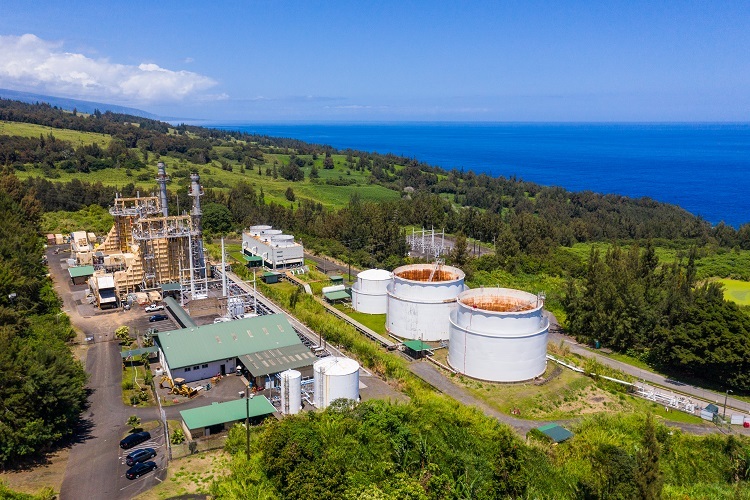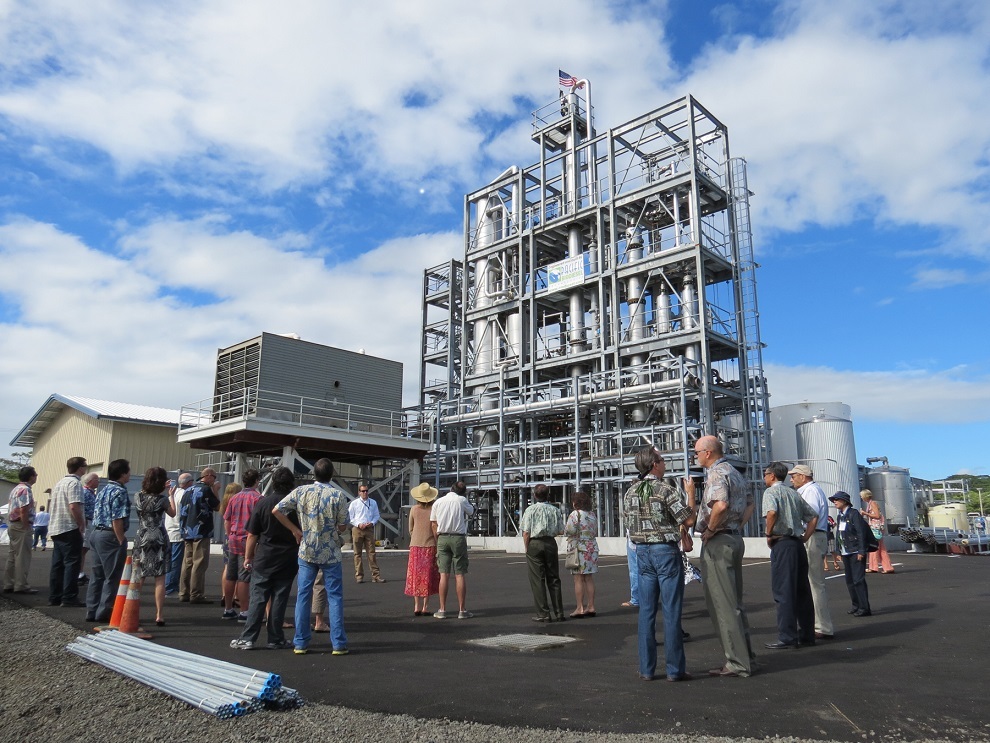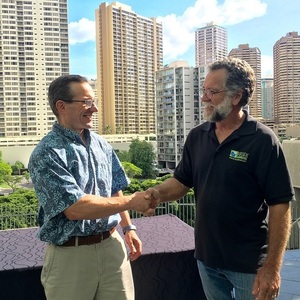New contract a big victory for Pacific Biodiesel, local movement




Photo: Pacific Biodiesel Technologies
October 29, 2019
BY Ron Kotrba
Under a newly signed contract, Pacific Biodiesel Technologies, owner and operator of a 5.5 MMgy biodiesel production facility on the Big Island of Hawaii, will supply Pacific Current’s 60 MW combined cycle power generation facility, Hamakua Energy, with biodiesel to fuel the power plant. The deal is a win for all parties involved, including the state and people of Hawaii, as the archipelago moves closer to a goal of 100 percent renewable energy by 2045 under the Hawaii Clean Energy Initiative.
Pacific Current acquired the Hamakua Energy facility in 2017 and sells power to Hawaii Electric Light Co. under an existing power purchase agreement. The plant is capable of providing 22 percent of Hawaii Island’s generating capacity.
“The plant was operating as a peaking facility,” said Scott Valentino, president of Pacific Current. A peaking facility provides power during times of peak demand. Subsequent to Pacific Current’s acquisition of the Hamakua Energy plant, a violent eruption of the Kilauea volcano on Hawaii Island in 2018 took the Puna Geothermal Ventures plant, which was providing 40 MW of baseload power, offline.
“Hamakua Energy stepped into that role,” Valentino said, explaining that Pacific Current’s recently acquired peaking facility is now operating at more than 75 percent capacity to provide baseload power for the Big Island, filling the void left by the offline geothermal plant.
Before the contract with Pacific Biodiesel, the Hamakua Energy plant had been generating its power from either diesel fuel or naphtha, Valentino said. At 75 percent operating capacity, the plant can consume upward of 2.5 million gallons a month. “It’s pretty substantial,” he said. If the geothermal plant becomes operable again, however, this could change. “There is general support to get the geothermal plant back online,” Valentino said. Depending on the status of the Puna geothermal facility, Hamakua Energy may consume between 10 and more than 25 MMgy of fuel per year.
Advertisement
Pacific Current began permitting work nearly a year ago to be allowed to run the plant on biodiesel. “We did a test burn last December and we received our final air permit in June,” Valentino told Biodiesel Magazine. “Subsequent to that, we went into contract negotiations with Pacific Biodiesel.”
“This is a really good contract for us,” said Bob King, president and founder of Pacific Biodiesel. “The most important thing for us is our biodiesel is being used on the Big Island. Now, we ship most of our fuel to Oahu. The logistics of that is challenging.” Pacific Biodiesel strives to minimize its footprint and conduct business locally, so making biodiesel on the Big Island and having it consumed there is “exactly what we want to do with this plant,” King told Biodiesel Magazine.
Earlier this year, Pacific Biodiesel considered shipping its distilled, waste-based biodiesel fuel to California to stay afloat amid a market injured by federal policy uncertainty. “It pains me to even consider doing that,” King said. “Our mission is not to ship fuel all over. It was looking like we might have to, but this contract with Pacific Current solidifies that our fuel will stay in Hawaii. This contract is very important, most especially because of the federal situation. Pacific Current understands where we’re at, where the markets are at, and they’ve stepped up and helped us through these times right now when we’re not getting much help from the federal government. They’ve made a commitment to stay with us through the ups and downs. Economically, it’s good, and I have to say, for morale it’s good knowing that our local team has our back.”
In addition to the new contract to supply the Hamakua Energy facility with biodiesel, Pacific Biodiesel continues to provide biodiesel to the 50 MW Schofield Generating Station on Oahu.
Advertisement
Pacific Biodiesel’s first delivery of fuel to the Hamakua Energy power station will take place Nov. 4. King couldn’t disclose how many gallons the contract calls for, but he did say the guaranteed minimum and maximum volumes negotiated under the multiyear deal are significant. “We’ll have multiple truck deliveries per day,” Valentino said. “We try to maintain 24 days of inventory onsite to withstand any major events.”
After Nov. 4, however, petroleum diesel fuel deliveries to Hamakua Energy will be a thing of the past. The plant will either run on 100 percent naphtha or 100 percent biodiesel at any given time.
Pacific Biodiesel not only produces biodiesel made from locally sourced waste oils, but it also runs its production facility on the Big Island and its delivery trucks entirely on biodiesel. King said the plant uses distillation column bottoms to fuel its boiler and the manufacturing plant uses a generator powered by its own biodiesel to supply electricity to the site.
When asked whether adding new contracts like the one with Pacific Current might spur Pacific Biodiesel to increase its fuel production capacity on the Big Island, King said, “Sure, I think these are the kinds of contracts that get us and others excited about putting in more capacity. But we see it as being more complicated than that because we must also then increase feedstock. We’ve been doing farming, developing an economic model for growing oil and food crops in Hawaii, and part of the reluctance to get further into that has been the durability of the market for biodiesel. These contracts put the market on more solid ground for us. Hopefully this will encourage us and others to get more serious about putting dollars into the farming side. These things take a long time though. I think we have to push aggressively to get things rolling so by the time we need it—really, really need it—we have already adequately built the farming, processing and customer model.”
Hawaii views biodiesel as an important part of the fuel mix going forward, according to Valentino. “It is our hope to increase production locally rather than shipping fuel in,” he said.
Related Stories
The U.S. Energy Information Administration maintained its forecast for 2025 and 2026 biodiesel, renewable diesel and sustainable aviation fuel (SAF) production in its latest Short-Term Energy Outlook, released July 8.
XCF Global Inc. on July 10 shared its strategic plan to invest close to $1 billion in developing a network of SAF production facilities, expanding its U.S. footprint, and advancing its international growth strategy.
U.S. fuel ethanol capacity fell slightly in April, while biodiesel and renewable diesel capacity held steady, according to data released by the U.S. EIA on June 30. Feedstock consumption was down when compared to the previous month.
XCF Global Inc. on July 8 provided a production update on its flagship New Rise Reno facility, underscoring that the plant has successfully produced SAF, renewable diesel, and renewable naphtha during its initial ramp-up.
The USDA’s Risk Management Agency is implementing multiple changes to the Camelina pilot insurance program for the 2026 and succeeding crop years. The changes will expand coverage options and provide greater flexibility for producers.
Upcoming Events










